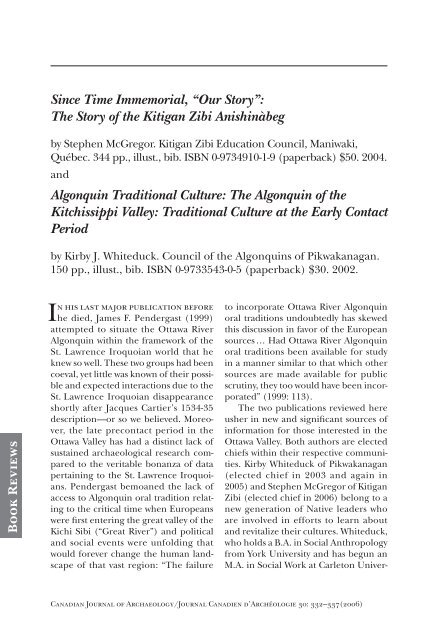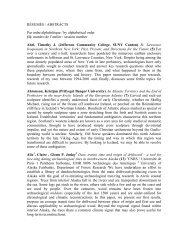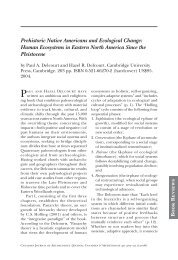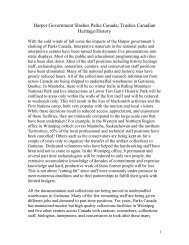Since Time Immemorial, “Our Story” - Canadian Archaeological ...
Since Time Immemorial, “Our Story” - Canadian Archaeological ...
Since Time Immemorial, “Our Story” - Canadian Archaeological ...
You also want an ePaper? Increase the reach of your titles
YUMPU automatically turns print PDFs into web optimized ePapers that Google loves.
<strong>Since</strong> <strong>Time</strong> <strong>Immemorial</strong>, <strong>“Our</strong> <strong>Story”</strong>:<br />
The Story of the Kitigan Zibi Anishinàbeg<br />
by Stephen McGregor. Kitigan Zibi Education Council, Maniwaki,<br />
Québec. 344 pp., illust., bib. ISBN 0-9734910-1-9 (paperback) $50. 2004.<br />
and<br />
Algonquin Traditional Culture: The Algonquin of the<br />
Kitchissippi Valley: Traditional Culture at the Early Contact<br />
Period<br />
by Kirby J. Whiteduck. Council of the Algonquins of Pikwakanagan.<br />
150 pp., illust., bib. ISBN 0-9733543-0-5 (paperback) $30. 2002.<br />
Book Reviews<br />
In his last major publication before<br />
he died, James F. Pendergast (1999)<br />
attempted to situate the Ottawa River<br />
Algonquin within the framework of the<br />
St. Lawrence Iroquoian world that he<br />
knew so well. These two groups had been<br />
coeval, yet little was known of their possible<br />
and expected interactions due to the<br />
St. Lawrence Iroquoian disappearance<br />
shortly after Jacques Cartier’s 1534-35<br />
description—or so we believed. Moreover,<br />
the late precontact period in the<br />
Ottawa Valley has had a distinct lack of<br />
sustained archaeological research compared<br />
to the veritable bonanza of data<br />
pertaining to the St. Lawrence Iroquoians.<br />
Pendergast bemoaned the lack of<br />
access to Algonquin oral tradition relating<br />
to the critical time when Europeans<br />
were first entering the great valley of the<br />
Kichi Sibi (“Great River”) and political<br />
and social events were unfolding that<br />
would forever change the human landscape<br />
of that vast region: “The failure<br />
to incorporate Ottawa River Algonquin<br />
oral traditions undoubtedly has skewed<br />
this discussion in favor of the European<br />
sources … Had Ottawa River Algonquin<br />
oral traditions been available for study<br />
in a manner similar to that which other<br />
sources are made available for public<br />
scrutiny, they too would have been incorporated”<br />
(1999: 113).<br />
The two publications reviewed here<br />
usher in new and significant sources of<br />
information for those interested in the<br />
Ottawa Valley. Both authors are elected<br />
chiefs within their respective communities.<br />
Kirby Whiteduck of Pikwakanagan<br />
(elected chief in 2003 and again in<br />
2005) and Stephen McGregor of Kitigan<br />
Zibi (elected chief in 2006) belong to a<br />
new generation of Native leaders who<br />
are involved in efforts to learn about<br />
and revitalize their cultures. Whiteduck,<br />
who holds a B.A. in Social Anthropology<br />
from York University and has begun an<br />
M.A. in Social Work at Carleton Univer-<br />
<strong>Canadian</strong> Journal of Archaeology/Journal Canadien d’Archéologie 30: 332–337(2006)
<strong>Since</strong> <strong>Time</strong> <strong>Immemorial</strong>/Algonquin Traditional Culture • 333<br />
sity, has been involved in the Golden<br />
Lake land claim process for many years<br />
as a researcher, archivist and negotiator.<br />
McGregor’s passions are writing and storytelling,<br />
including radio, screenplays,<br />
novels and community exhibitions.<br />
He also participated in archaeological<br />
excavations undertaken by the community<br />
of Kitigan Zibi at Kabeshinàn<br />
at the mouth of the Gatineau River in<br />
2001 and 2002, learning firsthand about<br />
traditional material culture from the<br />
Middle Woodland period. Both authors<br />
are committed to producing useful<br />
sources of information about their<br />
heritage and communities to be shared<br />
with the larger public. While both would<br />
immediately acknowledge the absolutely<br />
critical role of the knowledge held by<br />
their elders, they also accept that other<br />
valid and important sources of information<br />
about the past exist in the form of<br />
written records kept in archives, old<br />
photographs, travelers’ narratives, and<br />
similar sources.<br />
These two books also demonstrate<br />
the willingness of the respective communities<br />
to endorse these projects. In<br />
both instances, the publications were<br />
made possible through the financial support<br />
and assistance of the band councils.<br />
These organizations have many issues to<br />
deal with on a daily basis and the decision<br />
to divert funds towards the publication<br />
of a book about history cannot be<br />
an easy one. That they did (and it must<br />
be pointed out that neither author was<br />
chief at the time) is, in my opinion, very<br />
much to their credit.<br />
Whiteduck’s objective in undertaking<br />
the research and publication of<br />
Algonquin Traditional Culture was to bring<br />
together pertinent and useful information<br />
about his Nation for anyone intent<br />
on studying the Algonquin of the early<br />
contact period. His book facilitates and<br />
encourages further research and demonstrates<br />
the wealth of information that<br />
exists and is accessible to scholars. In<br />
this way, he takes up the challenge put<br />
forward by Daniel Clément (1996: 4)<br />
in The Algonquins, where he stated that<br />
the “Algonquin should never again be<br />
considered as one of the most unknown<br />
Native groups in the literature.”<br />
For some time now, the chronicles<br />
sent to France from Canada by the Jesuit<br />
priests during the 17 th and 18 th centuries<br />
have been available via the internet. At<br />
the Library and Archives Canada website,<br />
one can consult images of every<br />
page of the original French language<br />
documents or their late-19 th /early-20 th<br />
century English translations (http://<br />
www.collectionscanada.ca/jesuit-relations/index-e.html).<br />
A fully searchable<br />
text version of Reuben Gold Thwaites’<br />
translation, The Jesuit Relations and Allied<br />
Documents, can also be accessed online<br />
(http://puffin.creighton.edu/jesuit/<br />
relations/). Scholars thus have much<br />
flexibility in their research approach.<br />
Whiteduck’s book is essentially a<br />
compilation of references to things<br />
Algonquin found within the Jesuit Relations<br />
and other relevant publications<br />
(Champlain’s and Sagard’s narratives,<br />
for example). These have been grouped<br />
into a number of chapters that reflect<br />
the categories of data available: Social<br />
Structure and Customs, Subsistence<br />
Patterns and Economic Customs, Material<br />
Culture, Political Structure and<br />
Customs, Spiritual Beliefs and Religious<br />
Customs, Medicines, Legends and<br />
Tales. These chapters are prefaced by<br />
a synthesis of the general archaeological<br />
view of the region’s ancient history.<br />
Although archaeologists will not find<br />
new information in this section, its very<br />
presence is heartening and suggests<br />
that Whiteduck views archaeology as<br />
Journal Canadien d’Archéologie 30 (2006)
334 • Pilon<br />
capable of providing useful information,<br />
and that it is not the sole domain<br />
of Euro-<strong>Canadian</strong>s.<br />
In his presentation of the data,<br />
Whiteduck makes extensive use of<br />
lengthy quotations from the English<br />
translations of the historic texts, which<br />
he usually prefaces with commentary<br />
intended to shed light on the context<br />
of the observation. He also provides<br />
syntheses of the customs being detailed<br />
because the language of the original can<br />
be somewhat obtuse and may reflect<br />
the original observers’ unfamiliarity<br />
with the cultural context, a situation<br />
sometimes compounded by the translation<br />
process. Whiteduck recognizes that<br />
these early observers carried a lot of cultural<br />
and philosophical baggage during<br />
their travels in the Ottawa Valley–lower<br />
Great Lakes region, and he cautions the<br />
reader against being too harsh in evaluating<br />
their work. The background of the<br />
writers and the context within which<br />
they were recording this information<br />
imposed very real limits on their ability<br />
to comprehend particular customs<br />
and practices, and greatly colored their<br />
reporting:<br />
When one reads the Jesuit descriptions<br />
of the Algonquins and other<br />
aboriginal nations as pagans,<br />
heathens, savages, infidels, filthy,<br />
arrogant and surly, one must be<br />
mindful that they are the descriptions<br />
and writings of people who<br />
were from a different country that<br />
had a vastly different culture and a<br />
Christian worldview with concrete<br />
opinions as to who is superior and<br />
right in God’s opinion. <strong>Since</strong> their<br />
intent was to eliminate and abolish<br />
the aboriginal way of life and to<br />
replace it with a Christian and civilized<br />
one, then their descriptions<br />
and opinions of the Indians and<br />
their aboriginal way of life were<br />
rarely favourable (p. 5).<br />
Given that the Internet now makes<br />
all of this material readily available and<br />
the extensive documents easily searchable,<br />
a legitimate question would be to<br />
ask whether it was worthwhile publishing<br />
such a book. In response, I would<br />
argue that by collating this information,<br />
contextualizing it, and providing critical<br />
commentary, Whiteduck has added<br />
much that simply finding this information<br />
electronically could not have<br />
offered. As such, this work is a valuable<br />
contribution to research on the first<br />
inhabitants of the Ottawa Valley.<br />
<strong>Since</strong> <strong>Time</strong> <strong>Immemorial</strong>, <strong>“Our</strong> <strong>Story”</strong><br />
is a different kind of book entirely.<br />
The research presented in this volume<br />
was actually begun in 1975 by Pauline<br />
Decontie, a Kitigan Zibi schoolteacher,<br />
picked up again by Ernest McGregor in<br />
1980, and finally completed by Stephen<br />
McGregor, assisted by Sandra Diabo-<br />
Decontie and James Odjick as researchers.<br />
This is the history of the Kitigan Zibi<br />
community. The book is divided into two<br />
parts, consisting of nine units with a total<br />
of 23 chapters.<br />
Part One begins with creation and<br />
first peopling, and ends with the experiences<br />
of Ottawa Valley Anishinàbeg<br />
under European colonial regimes.<br />
The first unit attempts to set the stage<br />
whereby the place of the Anishinàbeg<br />
as the legitimate heirs of Native history<br />
in this region is established. It begins<br />
with a recounting of traditional stories<br />
of creation, not solely the Anishinàbeg<br />
one, recognizing that there are multiple<br />
accounts that crosscut cultural boundaries.<br />
This is a tacit recognition that the<br />
current membership of the Kitigan Zibi<br />
Anishinàbeg can trace connections to<br />
<strong>Canadian</strong> Journal of Archaeology 30 (2006)
<strong>Since</strong> <strong>Time</strong> <strong>Immemorial</strong>/Algonquin Traditional Culture • 335<br />
different cultures that equally deserve<br />
respect. In a similar vein, the scientific<br />
account of the creation of the Ottawa<br />
Valley is presented along with limited<br />
archaeological information pertaining<br />
to its early inhabitants. In one respect,<br />
this is a claiming process whereby the<br />
distant past is declared pertinent to the<br />
current Native descendants of those<br />
distant bands regardless of the ethnic<br />
and cultural labels they may have held<br />
or have since had ascribed to them. It<br />
legitimately takes possession of a past<br />
with which they, more than anyone else,<br />
identify in a very real sense. It is also an<br />
unstated acknowledgement that archaeology<br />
can provide their community<br />
with important evidence of their past<br />
and a connection to their ancestors.<br />
In fact, archaeology serves as a foundation<br />
for describing the process whereby<br />
the Kichi Sibi Anishinàbeg came into<br />
being:<br />
… the Paleo evolved into the<br />
Archaic peoples. As the population<br />
of the Archaic people increased,<br />
they dispersed into regions to<br />
maintain the balance of game animals.<br />
It was through this evolutionary<br />
process that the Anishinàbe of<br />
the Eastern Woodlands came to<br />
be … One of these groups was the<br />
Kichi Sibi Anishinàbeg, the people<br />
who lived along the Ottawa River<br />
and its tributaries (p. 18).<br />
McGregor also describes some of<br />
the characteristics that serve as ethnic<br />
markers for the Kichi Sibi Anishinàbeg<br />
people themselves: the importance of<br />
the birch back canoe, hunting, trade,<br />
some elements of social structure, and<br />
the place of the Kichi Sibi (the Ottawa<br />
River) as a network of communication<br />
over vast areas.<br />
Subsequent units detail <strong>Canadian</strong><br />
history from the perspective and involvement<br />
of the Anishinàbeg. This was one<br />
of the most interesting aspects of the<br />
book. Although approached chronologically,<br />
the focus is not so much the presentation<br />
of the time period as an attempt to<br />
insert the Anishinàbeg into that period.<br />
The story is not new, but the reader’s<br />
attention is constantly being drawn away<br />
from those who have been considered<br />
the main actors and brought to bear<br />
on those who seem to sit quietly on the<br />
sidelines, yet are markedly impacted by<br />
what was happening on center stage.<br />
As one who was raised in the Ottawa<br />
Valley, I was disturbed by the number of<br />
times where my reaction to a new bit of<br />
information about yet another bruising<br />
the Anishinàbeg community had suffered,<br />
was to observe that “I didn’t know<br />
that.” So much for what remained of my<br />
innocence!<br />
The second part of the book deals<br />
with the circumstances that compelled<br />
a group of Anishinàbeg under the<br />
leadership of Paginawatik to leave the<br />
reserve that had been accorded them<br />
by the king of France at Oka to establish<br />
a community at the confluence of the<br />
Gatineau and Desert Rivers. From this<br />
initial settlement, lands were slowly, but<br />
surely, taken, surrendered and given<br />
away until little remained. Throughout<br />
this section, which brings us up to the<br />
present day, we learn about how the<br />
community changed and adapted to new<br />
circumstances and hurdles—it is a story<br />
of survival.<br />
McGregor rightly points out the<br />
contributions that his forefathers have<br />
made throughout the four centuries of<br />
Anishinàbeg–European relations, and<br />
he points out how they so often seemed<br />
to have lost out in their “beaux risques.”<br />
As an avid student of military history,<br />
Journal Canadien d’Archéologie 30 (2006)
336 • Pilon<br />
he often frames his discussion of events<br />
in the language of military strategy or<br />
deals extensively with military developments.<br />
An entire chapter is devoted<br />
to the contributions of Kitigan Zibi<br />
Anishinàbeg to the First World War, and<br />
later chapters document the community’s<br />
continued military contributions<br />
(World War II, Korea, Vietnam). After<br />
all, is not putting your life, or the lives<br />
of your sons, on the line the ultimate<br />
price for respect? Is that not enough<br />
to earn proper treatment as a people?<br />
Yet nearly every time period saw the<br />
loss of land, the loss of rights, the loss<br />
of respect.<br />
The book is lavishly illustrated with<br />
archival watercolor drawings, original<br />
pen and ink artwork by Kitigan Zibi<br />
artist Dean Ottawa, maps, and photographs.<br />
Chapter texts are also complemented<br />
with short vignettes, set off<br />
from the main text by a birch-bark-like<br />
background, constantly reminding the<br />
reader of the historical importance<br />
and cultural significance of that tree.<br />
McGregor also provides numerous colorful<br />
stories that recreate some of the<br />
human dimension of the times detailed<br />
in each chapter.<br />
Some historians may quibble with<br />
facts and interpretations presented in<br />
this work, which may occasionally appear<br />
harsh. For example, McGregor states<br />
that, “The ultimate purpose of Christianity<br />
was to convert all nations and all<br />
people to the word of Jesus Christ. This<br />
set the stage for 2,000 years of religious<br />
conflicts worldwide” (p. 32). Elsewhere<br />
we read that, “Alcohol was the catalyst<br />
that disrupted First Nations society and<br />
its introduction by the Europeans four<br />
hundred years ago remains to this day,<br />
the longest running genocide of First<br />
Nations communities” (p. 84). Careful,<br />
critical, contextual reading is recommended.<br />
However, there seems to be<br />
such an overwhelming amount of data<br />
pointing to the systematic marginalization<br />
and exploitation of the Anishinàbeg<br />
community that it cannot be denied. Yet,<br />
children are still taught in non-Native<br />
schools about some idealized time<br />
before the arrival of Samuel de Champlain<br />
when Native people lived in the<br />
Ottawa Valley “in harmony with nature.”<br />
We learn how Champlain’s arrival began<br />
the disruption of traditional patterns<br />
and how the Anishinàbeg withdrew<br />
from the river following intense raiding<br />
by marauding Iroquois and lived on<br />
the valley’s edges. History then begins<br />
in earnest with the arrival of Philemon<br />
Wright in 1800 (but not really because<br />
he settled on the Quebec side of the<br />
river) and especially with Lt. Col. John<br />
By and the building of the Rideau Canal<br />
some 30 years later. The rest, as they say,<br />
is history—but a history that no longer<br />
includes Native people.<br />
Algonquin Traditional Culture and From<br />
<strong>Time</strong> <strong>Immemorial</strong> differ in their purposes,<br />
yet they complement each other quite<br />
well. Each provides details of periods<br />
not covered by the other or dealt with<br />
only superficially. Whiteduck’s book<br />
reads as an ethnographic/ethnohistoric<br />
treatment of contact period Anishinàbeg<br />
culture, while McGregor’s presents<br />
political and economic history from that<br />
time onward, liberally sprinkled with<br />
an Anishinàbeg perspective, in order<br />
to understand the present-day Ottawa<br />
Valley Anishinàbeg and more specifically<br />
the community of Kitigan Zibi.<br />
In my opinion, the information<br />
contained in these books should be<br />
integrated into the history curricula of<br />
the Ottawa Valley’s schools, regardless<br />
of which side of the river the students<br />
live on or what their ethnic origins<br />
are. The story of what happened to the<br />
<strong>Canadian</strong> Journal of Archaeology 30 (2006)
<strong>Since</strong> <strong>Time</strong> <strong>Immemorial</strong>/Algonquin Traditional Culture • 337<br />
Anishinàbeg needs to be known and<br />
understood by Natives and non-Natives<br />
alike. If nothing else, knowledge of<br />
this history would facilitate the general<br />
public’s understanding of why Eastern<br />
Ontario, for example, is currently the<br />
subject of a comprehensive land claim<br />
and that we are legally squatters on<br />
someone else’s land. This would provide<br />
much-needed detail to the otherwise<br />
hollow-sounding affirmation that before<br />
Champlain, “First Nations used to live<br />
here.” In this regard, I am certain that<br />
Jim Pendergast would have welcomed<br />
both of these publications.<br />
REFERENCES CITED<br />
Clément, D.<br />
1996 The Algonquins. <strong>Canadian</strong> Ethnology<br />
Service Mercury Series No.130,<br />
<strong>Canadian</strong> Museum of Civilization,<br />
Hull.<br />
Pendergast, J.F.<br />
1999 Ottawa River Algonquin Bands<br />
in a St. Lawrence Iroquoian Context.<br />
<strong>Canadian</strong> Journal of Archaeology 23:<br />
63–136.<br />
Jean-Luc Pilon<br />
<strong>Canadian</strong> Museum of Civilization<br />
Gatineau, Québec<br />
Journal Canadien d’Archéologie 30 (2006)








